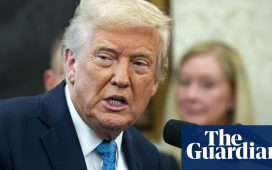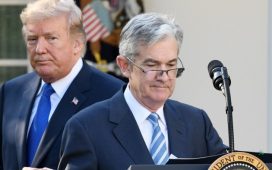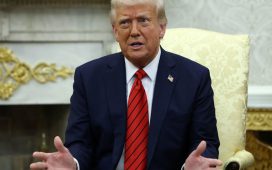This article is an on-site version of our Central Banks newsletter. Sign up here to get the newsletter sent straight to your inbox every Tuesday
Greetings from Washington, where we’re gearing up for what promises to be a lively 2024. I’m Claire Jones, standing in for Chris Giles.
Federal Reserve chair Jay Powell finished 2023 in high spirits, delivering a dovish message on December 13 along with forecasts that show most rate-setters are now firmly in the soft-landing camp.
That is, the rate-setting Federal Open Market Committee believes unemployment will rise only a touch above current levels as inflation shows more progress towards steadying around rate-setters’ targets of 2 per cent.
That progress means that, as we head into the new year, most people expect the Fed to call time on a rate-raising cycle that saw officials lift interest rates by 525 basis points since March 2022 to a 22-year high.
The big question is by how much will they cut.
A better than expected 2023, which saw US growth outpace almost every other advanced economy and inflation decline sharply, has paved the way for officials to predict they’ll make three quarter-point cuts to interest rates over the coming 12 months. However, many investors expect more than that, with futures markets pricing in as many as six cuts this year.
At the moment, a lot of economists’ bets are somewhere in between what rate-setters and markets expect. One explanation for the variation is that there’s a lack of clarity about how the US central bank thinks about financial conditions.
In early November, Powell sounded the alarm about an excessive tightening of financial conditions. In the six weeks leading up to the penultimate meeting of 2023, the US government’s cost of borrowing for 10 years had soared by about 50bp to 4.88 per cent. The rate of interest on a 30-year mortgage, meanwhile, hit 7.79 per cent on October 26, the highest level since 2000.
That de facto tightening prompted the Fed to add the bold text to its policy statement:
Tighter financial and credit conditions for households and businesses are likely to weigh on economic activity, hiring and inflation. The extent of these effects remains uncertain.
Those two words might not sound like much. But for Fed-watchers they were seen as enough to imply that officials felt as though the markets’ pricing of risk was doing some of their work for them, meaning that there was less need to consider rate increases.
In the six weeks leading up to the December vote, however, financial conditions eased substantially. The 10-year yield dropped to 4.2 per cent, while bets on rate cuts helped to lower the 30-year mortgage rate to just a touch above 7 per cent.
That had led some to speculate ahead of the meeting in December that the Fed would drop the reference to “tighter” financial conditions.
In the event, that line remained — suggesting that even more easing in borrowing costs would be tolerated. It also surprised many that when asked directly by Nick Timiraos of the Wall Street Journal how he felt about markets easing policy on his behalf, the Fed chair appeared sanguine, saying that despite the “back and forth” on market movements, he and his fellow rate-setters were “just focused on what’s the right thing for us to do”.
He also said that, in the long run, it was important that financial conditions became aligned with what rate-setters were trying to accomplish, and that “ultimately” they would be.
But it’s hard to see how we get to that point in an environment where the Fed’s response to gyrations in financial markets is rather opaque.
So how much easing of borrowing conditions would constitute too much? Since the meeting, the 10-year Treasury yield has fallen to 3.88 per cent. The 30-year mortgage rate is 6.61 per cent.
The kickback from other FOMC members since the decision suggests some rate-setters are not keen on market pricing that effectively strong-arms them into cutting rates as soon as March. But, other than that, economists say there is little clarity.
“The Fed had spoken not that long ago about the market doing some of the work for them,” said Andrew Patterson, economist at Vanguard. “Now equities are up seven or eight weeks in a row. Investors are no longer helping bring inflation down. In fact, we think the opposite is happening right now.”
“The inconsistency in guidance on how important the financial conditions index is gives you the impression that they make their minds up and then look for evidence that supports their position,” said Gavyn Davies, chair of Fulcrum Asset Management. “If the evidence changes, but they don’t necessarily change with it, then that’s confusing.”
There may be more clues in the minutes of the December vote, which are due out in the coming weeks.
If the Fed gets its wish and its shift into the soft-landing camp proves correct, it may remain pretty happy with financial conditions easing. Signs that inflation is proving more durable than it hoped, however, might bring some kickback.
My best bet is that the Fed’s forecasts will prove reasonably accurate, and its communications will prove a little clearer as the data confirms that price pressures in the US are indeed dissipating. Until then, though, expect some uncertainty in reading the runes of how US rate-setters think about how markets are pricing things.
What I’ve been reading
-
Tej Parikh thinks Team Transitory is still wrong, despite recent falls in inflation.
-
I enjoyed Nic Fildes’ take on Australian kids’ TV phenomenon Bluey.
-
This, by Martin Sandbu, on the rise (and recent reputational hit) to the philosophy of effective altruism is worth a read.
A chart that matters
The US performed far better than the eurozone economy in 2023. Economists think that trend will continue into 2024, according to a poll conducted by Martin Arnold and Alexander Vladkov from the FT’s Frankfurt bureau, which shows growth in the bloc of 20 member states is set to remain weak. Here are the main threats to growth:










